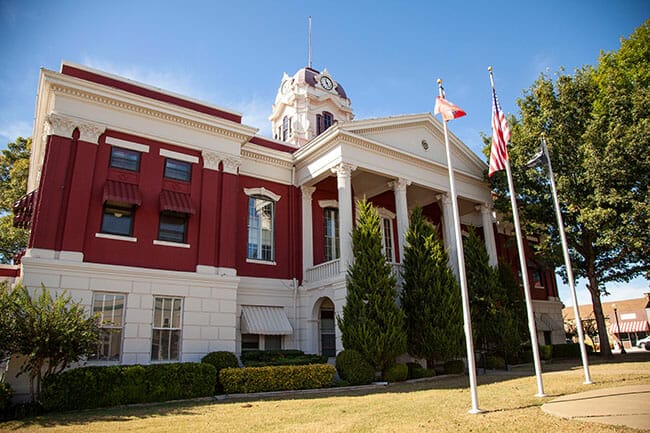

Uh oh...
It appears that you're using a severely outdated version of Safari on Windows. Many features won't work correctly, and functionality can't be guaranteed. Please try viewing this website in Edge, Mozilla, Chrome, or another modern browser. Sorry for any inconvenience this may have caused!
Read More about this safari issue.

You’re never too young or too old to appreciate history. My step-father-in-law turns 90 in a few weeks and can tell so many incredible stories about the history of the land, the towns and the people who have lived and worked in White and Jackson Counties since the 1930s. Eighty-five years separate him from my 5-year-old son, George, who sits in wonder as Grampy tells stories about his youth.
I don’t know what my son will be when he grows up. His interests are many, but he certainly loves hearing the history of the towns and people around us. He soaks up the knowledge in his youthful brain, hopefully storing it away so he can repeat the stories to his own grandchildren someday. We recently took an afternoon to investigate some interesting historic properties across White County.
History of White County
White County was established in 1835 with just 929 residents, but its history began long before. In 1541, the first Europeans traveled through the area with the Hernando De Soto expedition but didn’t stick around long. While other explorers passed through, the first settlers didn’t establish homesteads until 1818.
Over the years, the country thrived through cotton production and a series of cotton gins along the Little Red River, the Strawberry trade in Bald Knob and the ice cream industry when Yarnell’s (now Turkey Hill) opened for operation in 1933. As towns grew throughout the county, construction of homes, churches and businesses increased as people settled and made White County their home.
Today, the county is home to nearly 80,000 people, and while it has seen tremendous growth, there is also a loss of history. As new construction is needed, older, historical properties are demolished or simply lost to the effects of time. Progress means change, and the old makes way for the new. As each day passes, some of the historical properties sprinkled throughout the county fade further into the background. Telling their story and repeating it over and over as Grampy does for George may be the only thing that saves them.

Benjamin Clayton Black House – 300 E. Race St., Searcy
The Benjamin Clayton Black House was initially built in 1858 as a two-room log cabin. Benjamin Clayton Black, mercantile and University of Arkansas board member, purchased the pre-Civil War home in 1866 and began extensive additions which brought the home to its current state. The house now serves the community as the Searcy Arts Council and the Searcy Art Gallery location. Learn more about the Black House and how it gives a voice to artists.

Photo by Liz Harrell
Pattie Cobb Hall – Harding University Campus, Searcy
People recognize the connection between Searcy and Harding University, but many don’t know that the campus was originally built as Galloway Female College in 1899. Pattie Cobb Hall, which now serves as a women’s dormitory for Harding University, was built in 1919. The interior of the building has seen many changes, but the exterior, a variation of Colonial Revival style, has held the same magnificence for over 100 years. Learn more about The Queen of Campus.

Photo courtesy of Arkansas Department of Parks, Heritage and Tourism.
Rialto Theater – Race St., Searcy
The Rialto Theater makes an impression on downtown Searcy both day and night. The Art Deco-Style building, a result of a 1940 remodel of the original 1920 structure, is modern and decorative and the neon sign is an icon of the city. The single-screen theater is going through a multi-phase renovation which began with the building’s facade and the neon sign and has continued to include work on the building’s interior. Movies are shown in the Rialto daily.

Photo by Valis55 – Own work, CC BY-SA 3.0
Col. Ralph Andrews House – 517 W. Center St., Beebe
Constructed in 1885, the Col. Ralph Andrew House is a shining example of vernacular, cross-shaped structures common in White County during the Railroad Era. The Folk Victorian spindle work and balustrades are beautiful examples of the attention to detail that was significant during construction. It is one of the best remaining examples of the time.

Photo by Valis55 – Own work, CC BY-SA 3.0
Stipe Cotton Gin – Florida and Cypress St., Beebe
Built in 1930, the Stipe Cotton Gin served Beebe and the surrounding communities for about 10 years. Farmers in the area brought their cotton to the steel and corrugated metal two-story gin for its initial processing before storing or transporting it for further processing. The Stipe Cotton Gin operated a steam-powered compressor that pressed the cotton into 500-pound bails.

Byers Masonic Lodge / Bradford City Hall – 302 W. Walnut St., Bradford
The current home of the Bradford Library is the former Byers Masonic Lodge and City Hall building. The building is an example of craftsman-style architecture, and its main features include a fieldstone first story and a stucco second story. The city and the Masonic lodge joined forces to construct the building in 1934 for $1,574.

U.L. Hickmon Hardware Store – Main and 2nd St., Bradford
During the 1920s, when the Hickmon Hardware Store was built, commercial buildings were often designed to mirror current architectural trends. However, the Hickmon store was built in a unique stucco style that still stands out today. During the Great Depression, when many families were afraid to keep their money and valuables in the bank, U.L. Hickmon served as a quasi-banker and allowed townspeople to store their wealth in the building’s safe.

Campbell-Chrisp House – 102 W. Elm St., Bald Knob
Thomas J. Campbell, who helped establish the Bald Knob State Bank and served as one of the founders of the Bald Knob Strawberry Company, built this home for his family in 1899 at the height of growth and prosperity in Bald Knob. The home’s Romanesque Revival architecture includes some Colonial Revival influences and has remained essentially unchanged over the years. Learn more about the importance of strawberries to the Bald Knob community.

James Richardson Gas Station – 367 and Vine St., Bald Knob
This English Revival-style building was constructed as a gas station in the 1930s. The pumps have been removed, but otherwise, the building still stands as it was originally built. The building symbolizes the change from railroad travel to travel via modern vehicles and the subsequent downfall of the railroad industry. While the style of the building was typical in 1930s gas stations, very few examples remain today.

St. Richard’s Catholic Church – Hickory and Cleveland St., Bald Knob
Bald Knob is home to several old churches, but none exemplify the depression-era Rustic or Park style quite like St. Richard’s. The building style was popular with the Civilian Conservation Corp and the Works Progress Administration. The fieldstone walls make the building a thing of beauty.

Henry Klotz Sr. House – AR-367, Russell
The Henry Klotz Sr. House is one of only two prefabricated homes built in the area that remain. The home was ordered from the Sears Roebuck catalog and constructed by Herman Page in 1921 for the Klotz family, whose descendants still live in the area. Attempts to locate the floor plan in Sears Roebuck catalogs have been unsuccessful, but it was not uncommon for families to modify design plans to fit their needs. The home is still standing but is in disrepair and has been vacant for many years.

Russell Jail – AR-367 and Elm St., Russell
Built by the Works Progress Administration in 1935, the Russell Jail is one of three cast concrete jails in White County. The single-cell jail had a steel door and two small, barred windows. The jail served the community as a place to hold criminal offenders until they could be taken to one of the larger surrounding communities for further processing. The other jails are located in Beebe and McRae.

Judsonia Bridge – CR-66, Judsonia
Bridges themselves aren’t unique. But the Judsonia Bridge, also referred to as the “wagon bridge,” is a swing truss bridge with a Warren cantilevered truss design completed in 1924. The triangular-shaped trusses gave the bridge strength, while the swing system provided the ability to turn the bridge to continue to allow river traffic along the Little Red River while still letting vehicular traffic cross the river. The Judsonia Bridge was turned by hand, and it was considered an honor to ride the bridge as it turned.

Photo by Valis55 – Own work, CC BY-SA 3.0
James William Boggs House – Austin St., Pangburn
Built in 1908 by Jim Stiltz, the James Willam Boggs House is a shining example of vernacular homes built at the time. The one-and-a-half-story home served as a family residence for some time and housed the Pangburn telephone exchange. A shotgun house addition was made to the original structure early on. The two-room shotgun house, which served as a doctor’s office, was relocated from another part of town and attached to the home.

Photo by Valis55 – Own work, CC BY-SA 3.0
Booth Weir House – West First St., McRae
While many buildings are significant because of their architectural style, the Booth Weir House is more meaningful because of its residents. Built in 1911, the house is one of the few remaining examples of pre-World War I architecture in McRae. The home first served Bill Booth, McRae Mayor, during the 1920s. Booth was a prominent businessman and known for owning the town’s first automobile. Booth moved to a new home a few years later, and Dr. Vivian Weir took over the residence. A physician, surgeon and dentist, Weir was known for never refusing to see a patient who couldn’t pay and for giving away free medicine on Sundays.
Cover photo courtesy of Al Fowler.
Join the Conversation
Leave a Comment
5 responses to “15 Historic Properties in White County”
 Leave a Reply
Leave a Reply
We do the work.
You check your email.
Sign up for our weekly e-news.
Get stories sent straight to your inbox!












 Leave a Reply
Leave a Reply
Our house in Griffithville was a prefab house .My Dad ordered it from Tandy homes and it was delivered on two flatbed trucks .this was around 1970
[…] County has a rich history, and historic properties are located throughout the county. The history is diverse, and efforts have been taken to preserve […]
Very nice! Do you have a picture of the old Rodgers Hospital? I was born there.
[…] History can be art. Junk can be art. Street Alleys can be art. Metal can be art. Houses can be art. Courthouses can be art. Minerals can be […]
[…] Learn more about Historic Properties in White County. […]